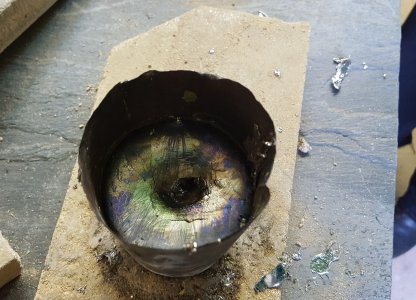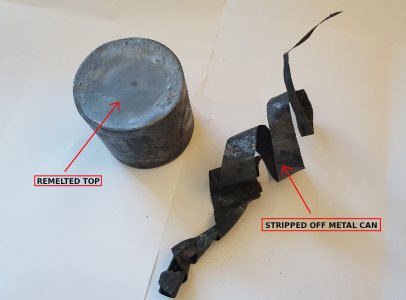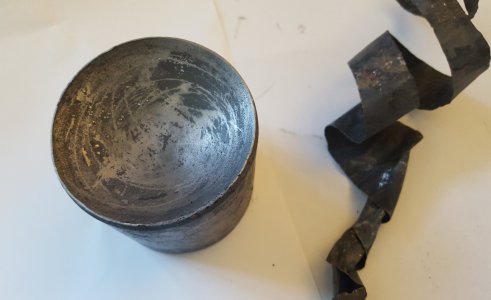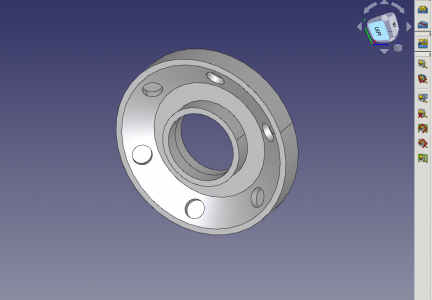- Joined
- May 27, 2016
- Messages
- 3,479
The melting of 2.1kG of lead in discard sacrificial half of a lube spray can in a woodburner turned out OK, though with lots of good experience.
That means lots of "don't ever do it that again" all the way to discovering how to deal with shrink voids in the top surface.
Originally from thread --> "Melting Lead Shenanigans", this is what happened.

Lead melts at only 327C (621°F), so putting the can among the wood coals in a living room woodburner was total overkill. Wood coals glow red hot, so are 700C to maybe 800C. Even so, it worked. Upon cooling, there was this big hole in the top surface. At first, I had no idea why.
Fill the hole
I went for a re-melt, this time done lots more conveniently using a regular plumber's butane/propane torch. I mean one of those atop a disposable hand-held fuel cannister. I stood the can on a piece of old fireplace insulation board, and just heated from the side. This time I could more easily stir (with borrowed screwdriver). Some yellow yuk slag and some bits of black stuff came to the top, so I dragged it to the side with a teaspoon, and scooped it out. I kept stirring, but very little more slag came out.

Then I got it that as the lower part cools, it shrinks from the outside. The fix was to let it cool, but keep re-melting from the top to keep the void filled. This, I guess, only happens when the top is wide open, and would not occur in a proper mold with sprues and vents. Clearly the cooled cylinder had shrunk lots more than the can, but it still would not just "drop out". I tore off the can in by twisting it around pliers "sardine can opener" style. It turned out better than I expected.
Upside down view.
A perfect replica of the shape of the bottom of the spray can.
Now we begin exploring what it takes to machine lead. I may need to give it a temporary aluminium disc screwed, glued, or somehow fixed onto one end, to have something that won't just go squish in chuck jaws. There is the need to bore a hole right through it. Drill press? Lathe? Whatever it takes to fit a support mandrel up it, so that one can have the other end held by a tailstock centre

I think the slag drag teaspoon looks well enough to get a wash and be returned to the kitchen before any confessions become necessary!
That means lots of "don't ever do it that again" all the way to discovering how to deal with shrink voids in the top surface.
Originally from thread --> "Melting Lead Shenanigans", this is what happened.

Lead melts at only 327C (621°F), so putting the can among the wood coals in a living room woodburner was total overkill. Wood coals glow red hot, so are 700C to maybe 800C. Even so, it worked. Upon cooling, there was this big hole in the top surface. At first, I had no idea why.
Fill the hole
I went for a re-melt, this time done lots more conveniently using a regular plumber's butane/propane torch. I mean one of those atop a disposable hand-held fuel cannister. I stood the can on a piece of old fireplace insulation board, and just heated from the side. This time I could more easily stir (with borrowed screwdriver). Some yellow yuk slag and some bits of black stuff came to the top, so I dragged it to the side with a teaspoon, and scooped it out. I kept stirring, but very little more slag came out.

Then I got it that as the lower part cools, it shrinks from the outside. The fix was to let it cool, but keep re-melting from the top to keep the void filled. This, I guess, only happens when the top is wide open, and would not occur in a proper mold with sprues and vents. Clearly the cooled cylinder had shrunk lots more than the can, but it still would not just "drop out". I tore off the can in by twisting it around pliers "sardine can opener" style. It turned out better than I expected.
Upside down view.
A perfect replica of the shape of the bottom of the spray can.
Now we begin exploring what it takes to machine lead. I may need to give it a temporary aluminium disc screwed, glued, or somehow fixed onto one end, to have something that won't just go squish in chuck jaws. There is the need to bore a hole right through it. Drill press? Lathe? Whatever it takes to fit a support mandrel up it, so that one can have the other end held by a tailstock centre

I think the slag drag teaspoon looks well enough to get a wash and be returned to the kitchen before any confessions become necessary!

